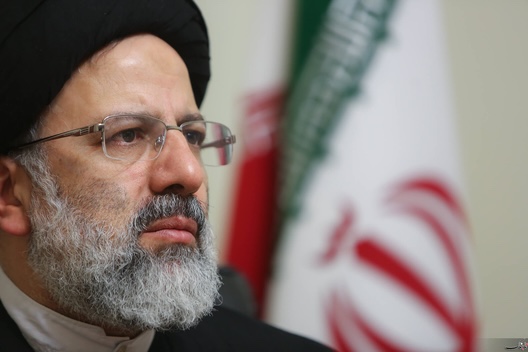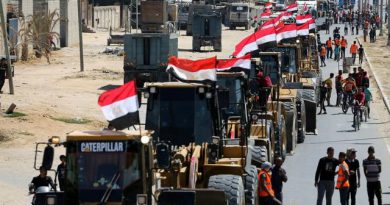IRAN: Khamenei’s Pick for the Presidency
by Cyrus Yaqubi
Khamenei is in fact, in a deadlock and deep crisis…
Finally, after much speculation, Khamenei favoured Ibrahim Raisi as his choice for the upcoming presidential election and put an end to all the ambiguities and rumours about the president he wishes to install. He had already prepared the grounds for this election on April 21.
On the one hand, a letter was sent by 220 members of the parliament, affiliated with his faction, asking Ibrahim Raisi to run for the presidency. On the other hand, he had eliminated potential rivals such as Hassan Khomeini (grandson of Ruhollah Khomeini) by advising him not to think of running for the presidency.
On several occasions in the past, Ibrahim Raisi had denied his willingness to run to play the game, but finally, on May 15, he agreed to bring this game to an end and announced his candidacy.
In reality, Khamenei’s most favourite candidate for the post would have been Qassem Soleimani, who was killed by American drones in Iraq. With Soleimani gone, Khamenei had no other choice than Ibrahim Raisi, who was appointed by himself as the head of Iran’s judiciary only about two years ago. There are still three years left of Raisi’s head of judiciary.
Putting these facts together reveals the fact that Khamenei is in fact, in a deadlock and deep crisis. According to informed observers, given Khamenei’s 82-year-old condition, he is unlikely to see the end of the next four-year presidency, and he will have to choose someone to replace him as the new Supreme Leader.
Of course, for some time now, the issue of combining the role of the supreme leader with the presidency has been raised among some of the regime’s leaders, and the election of Raisi to the presidency paves the way for this idea to materialize.
One of the reasons Khamenei is currently opposing the ongoing JCPOA talks in Vienna is that he wants these talks and agreements to occur during the next president’s time and the success of the talks go to the new president, Raisi.
But Ibrahim Raisi, who ran for president four years ago, is hated by the people for his direct involvement in the massacre of 30,000 political prisoners in the summer of 1988, most of whom were members and supporters of MEK.
Because of Raisi’s role in the 1988 massacre, he is referred to as Ayatollah Death; he could not get this seat in the last presidential election. His involvement in the crime was so obvious that even Hassan Rouhani mentioned it in his election speech 4 years ago, saying that Raisi had done nothing but issue death sentences, imprisonment and torture in the past 38 years.
But since Ibrahim Raisi was one of Khamenei’s most trusted figures, shortly after his defeat in the previous presidential election in March 2019, he was appointed as the head of the judiciary by Khamenei, one of the three main positions of power in Iran after the Supreme Leader.
Raisi’s appointment was considered as another step Khamenei had taken to bring his regime to more cohesiveness. In reality, Raisi was appointed to use his legal power and influence to eliminate any opposition of any form and shape. It is as if, in this short period of time, many dissidents who had done nothing but criticize Khamenei were sentenced to long prison terms, and a large number of political prisoners and dissidents were executed.
The dramatic increase in verdicts against political and civil activists during his tenure as head of the judiciary indicates a widespread wave of repression of civil society and critics in Iran.
It is good to note that just in the first six months of Ibrahim Raisi, as the head of the judiciary, judges have issued about 1,000 years prison terms and 1,400 lashes for civil and political activists. Raisi’s reign as the head of the judiciary has resulted in a 120 percent increase of repressive verdicts and sentences over the same period last year.
It is noteworthy that the government structure of the mullahs is similar to the structure of the Mafia, and they strengthen this structure with family ties. For example, the wife of Ibrahim Raisi is the daughter of Alam al-Huda, the Friday prayer leader of Mashhad the second-largest city in Iran. This makes Raisi, Alam-al-Hoda’s son-in-law. Alam al-Huda was elected to this position by Khamenei in 2006.
A year later, Alam al-Huda was elected as a member of the Assembly of Experts. In March 2016, he was appointed as Khamenei’s representative in Khorasan Razavi in order to have full authority in this province. And now, his son-in-law is set to take over the presidency and become the Supreme Leader in the next step.
But the fundamental question among experts is whether the appointment of Ibrahim Raisi as president can save the regime from this dangerous situation that many say is on the brink of collapse. In a situation where most people are planning to boycott the elections because of their hatred of the government, and with slogans such as “We have heard too many lies, we will not vote anymore” or “Our vote is overthrown,” the people have already expressed their views on not only the presidency but in relation to the whole system, regime change.
Cyrus Yaqubi is a Research Analyst and Iranian Foreign Affairs Commentator investigating the social issues and economy of the middle east countries in general and Iran in particular.



